|
|
|
| My Favourite Planet > English > Middle East > Turkey > Ephesus > photo gallery |
| Ephesus, Turkey |
Ephesus photo gallery 1 |
 |
 |
30 of 62 |
 |
 |
|
| |
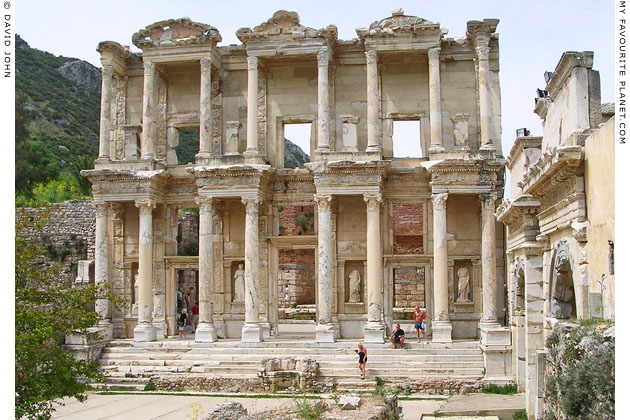
The Library of Celsus, completed around 135 AD. Right: the Gate of Mazeus and Mithridates. |
| |
The Library of Celsus
1. The history of the library
The imposing facade of the Library of Celsus is, apart from the Great Theatre, the most conspicuous and best-known monument in Ephesus, and for many the most attractive. It stands on the west side of what is now a large open square at the the lower (western) end of Kuretes Street, at the junction with the Marble Street that leads northwards to the Great Theatre and the harbour.
Steps from the junction of the streets lead down to the square which is on the same level as the Lower Commercial Agora. The monumental Gate of Mazeus and Mithridates, to the right (north) of the library leads into the Lower "Commercial" Agora.
The library building blocks what was a road, the continuation of Kuretes Street westwards towards Ortygia, a sacred location which according to local myths was the bithplace of Artemis and Apollo (see Selcuk gallery 1, page 3). The area around the library and market entrance was gradually converted to a grand square, a public space and showcase for the power and prosperity of the new capital of the Roman province of Asia.
The library was built by Tiberius Iulius Aquila Polmaeanus (70-75 - before 120 AD), who was a suffect consul in 110 AD, as a memorial to his father, the wealthy Tiberius Iulius Celsus Polemaeanus (Τιβέριος Ιούλιος Κέλσος Πολεμαιανός, circa 45 – circa 114 AD). Celsus, was from a Greek family of priests, either from Ephesus or Sardis. In 68 AD he was the tribune (commander) of the Legio quarta Scythica
(Scythian Fourth Legion) which sided with the part of the Roman army that proclaimed Vespasian as emperor in 69 AD. In turn Vespasian appointed him as a senator in 70 AD. He was suffect consul in 92 AD and Proconsul of Asia [1] 106-107 AD, during the reign of Trajan. He bequeathed the money for the building of the library in his will (see the inscription below).
Aquila died before the completion of the library, and another wealthy Ephesian, Tiberius Claudius Aristion (see Selçuk gallery 2, page 4), the executor of Celsus' will, took over the construction, completing it around 135 AD. [3]
The library was to become not merely a memorial but a heroon (mausoleum) for Celsus, and his enormous marble sarcophagus was placed in the building's basement (see gallery page 32). It is still there today, though unfortunately not accessible to visitors.
Above ground, the two-storey building was one of the largest libraries in the Graeco-Roman world, especially after the destruction of the Library of Alexandria by Julius Caesar and the removal of the 200,000 volumes of Pergamon's library by Mark Antony, allegedly as a gift for Cleopatra (see Pergamon gallery 2, page 20). The Library of Celsus could hold an estimated 12,000 papyrus scrolls.
The library was destroyed by a fire caused either by an earthquake in 262 AD, or the Goth invasion of 262-263 AD. The facade later became part of a fountain built with stone from other buildings, including the Parthian Monument which commemorated the victory of Emperor Lucius Verus over the Parthian Empire in 162-165 AD. The monument featured reliefs depicting the emperor, personifications of conquered cities and battle scenes. The originals are now in the Ephesos Museum in Vienna, but a cast of one of the reliefs can be seen in the Museum for the Visually Impaired in the Lower Agora.
The facade was restored again around 400 AD, but was finally demolished by an earthquake during the Byzantine era. Over the following centuries many of the marble parts were carried off to be reduced to lime for building material.
The building was excavated in 1905-1906 and partially reconstructed from original elements. Many of these elements, particularly the statues from the facade, were later taken to museums in Vienna and Istanbul, including the statue of Celsus himself (see photos, right).
The library was restored 1970-1978 by archaeologist Volker Michael Strocka and architect Friedmund Hueber [4]. They incorporated original stones found on the site, copies of architectural members that had been removed to various museums, as well as some new columns and reinforced concrete for structural stability. The reconstructed building is now the best preserved ancient library of the Graeco-Roman world. |
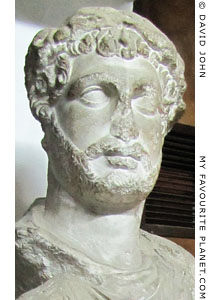
Head of the statue of Tiberius
Julius Celsus Polemaeanus
which originally stood in the
central niche of the upper
storey of the Celsus Library.
2nd century AD. [2]
Istanbul Archaeological
Museum. Inv. No. 2453. |
| |
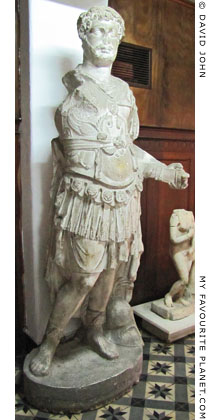
The statue of Celsus
in full length. |
| |
| |

The facade of the Library of Celsus from the lower end of Kuretes Street.
Around the square in front of the library stood several other monuments, including
the Gate of Mazeus and Mithridates (right) to the Lower Commercial Agora.
|
The best time of day to visit Pergamon is usually early in the morning, before the crowds arrive. Since the library facade faces east, morning is also the time to see the building in the best light.
As with many steps and stairways on open spaces around the world, especially at grand buildings and monuments (the Anteros statue at Piccadilly Circus and the National Gallery in London, the Spanish Steps in Rome, the Temple of Apollo at Didyma ...), tourists can not resist the temptation to sit and eat, drink and take a zillion selfies on the steps of the library, sometimes in large groups, so that the square in front of it becomes very crowded.
In a way you can't blame them, as this is one of the few places in the archaeological site where you can sit down and take a breather. On the other hand, with the huge crowds which now swarm over Ephesus, it does become nearly impossible to actually get a look at the building.
The photos above were taken in 2004, before Ephesus became a target of mass tourism, and particularly the advent of mega cruise ships and religious "pilgrimage" tourism on the present huge scale. By comparison, visiting the site in previous decades was very relaxed, and you were most likely to get into interesting conversations with the guards and other visitors.
Now such sites have become big business, with ever more coachloads of tourists being herded around by tour guides who shout their narratives at their groups. Trying to be polite, you wait until the group has moved on before attempting to look at a particular monument, but the next group arrives immediately after the previous one. This phenomenon is no longer restricted to the summer, as the endless tourist flow now continues all year round. |
|
|
| |
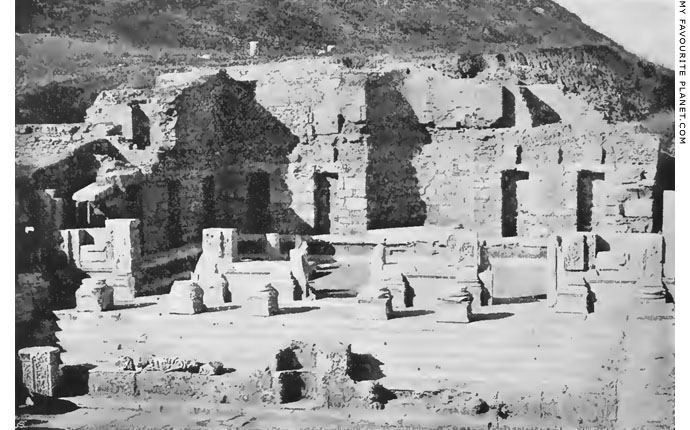
A photo of the Library of Celsus following its excavation in 1905-1906, but before the first
partial reconstruction of the facade. The many surviving architectural members were taken
elsewhere to be examined, measured and prepared for the reconstruction.
Image source: Wilhelm Wilberg, Die Fassade der Bibliothek in Ephesus, May 1908.
In: Jahreshefte des Österreichischen Archäologischen Institutes in Wien, Band XI,
pages 118-135, Fig. 21. Alfred Hölder, Vienna, 1908. At the Internet Archive. |
| |
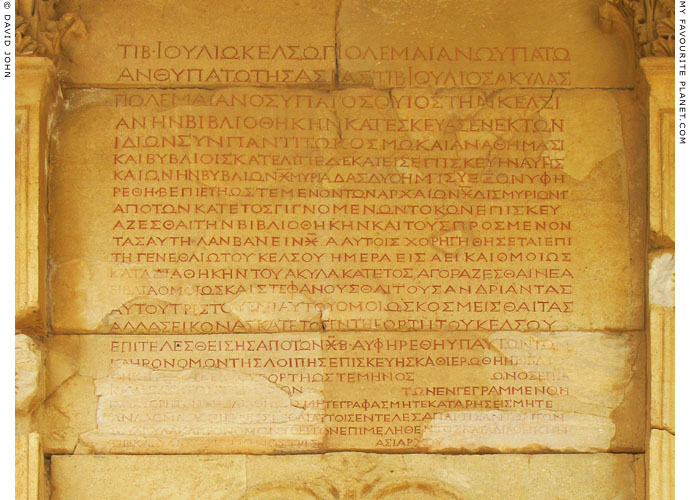
The Greek inscription with the will of Tiberius Iulius Celsus Polemaeanus
on the facade of the Library of Celsus, between two pilasters, above the
statue of "Sophia Kelsou" (see next page).
The will states that Celsus' son Aquila has built the library with his own money.
It also details how much money Celsus has beqeathed for the building, for purchasing
books and for commemorating him annually. It also states that Tiberius Claudius Aristion
(see Selçuk gallery 2, page 4), as the executor of his will, has completed the construction.
The inscription is set quite high, between 6.3 and 4.8 metres above floor level. The letters
of the 24 lines of text are 4.5 cm tall at the top, diminishing to 2 cm at the bottom.
See translations of the inscription in Geman and English below. |
| |
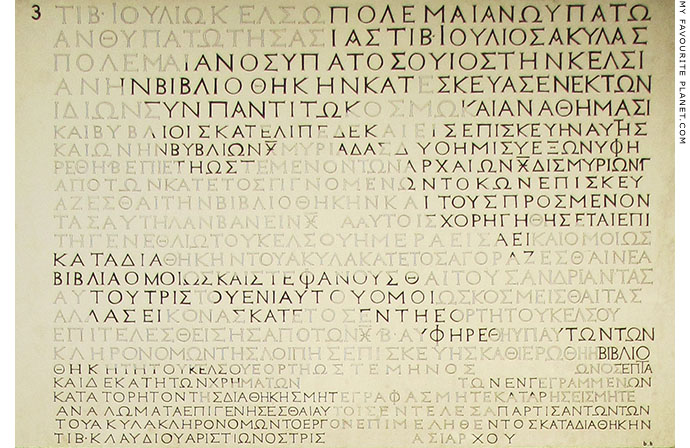
A reconstruction of the inscription in Greek, displayed inside the library. |
| |
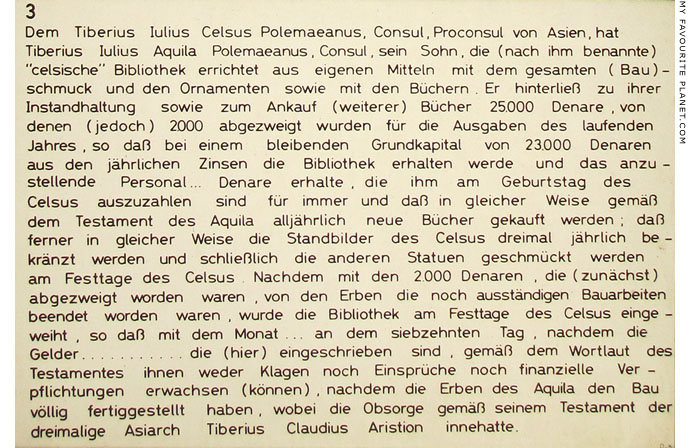
A translation of the inscription in German. |
| |
The inscription in English:
"To Tiberius Julius Celsus Polemaeanus, consul, proconsul of Asia. Tiberius Iulius Aquila Polmaeanus, consul, his son, built the [after him named] "Celcius" library from his own means with the entire [architectural] decorations and ornaments as well as the books.
He bequeathed for its maintenance and the purchase of [further] books 25,000 dinars, from which [however] 2000 were diverted for the expenditures of the current year, so that from the annual interest on the remaining capital of 23,000 dinars the library will be maintained and its attendants will be paid [800] dinars, to be paid out in perpetuity on the birthday of Celsus.
And in the same way, according to the will of Aquila, new books for the library shall be purchased every year. Furthermore, the statues of Celsus shall be crowned three times a year; and finally the other statues should be decorated on the [birthday] feast of Celsus.
After the completion of outstanding building work, for which the 2000 dinars were diverted from the bequest, the library was consecrated on the feast day of Celsus, so that with the month ... on the 17th day, after which the money ............ which are [here] inscribed, according to the wording of the testament, no litigation nor claim nor financial responsibility can arise, after the heirs of Aquila have completed the building, since according to his testament they are wards of Tiberius Claudius Aristion, three times Asiarch."
Inscription IvE 5113. |
|
|
 |
|
|
|